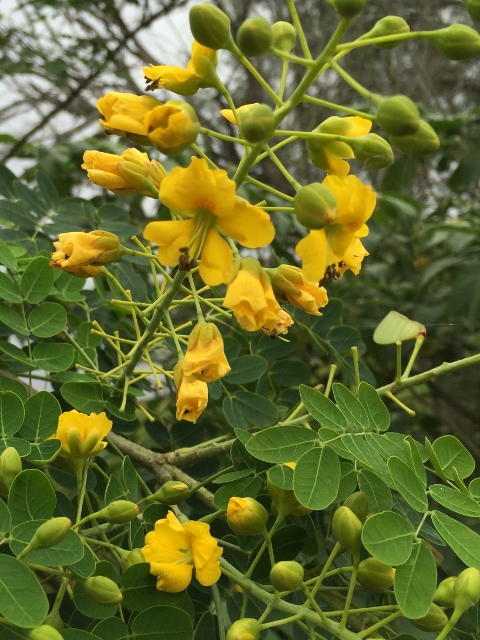
It’s tree planting time in the Valley
by Anita Westervelt, Texas Master Naturalist
November through February is optimal tree-planting time in the Valley. Cooler months allow trees a dormant period when roots can grow without heat and drought stress. Trees will be more established and flourish with spring rains.
Criteria for planting anything should be: “what can it do for me?” Payload is important, especially in smaller gardens. Planting small native trees-with-a-purpose give endless hours of nearly maintenance-free entertainment.
Yellow sophora, Sophora tomentosa, is an airy, wispy-looking large shrub. It is a prolific bloomer with soft, pastel yellow blooms spring through fall. The blooms attract butterflies, hummingbirds and other pollinators.
When the blooms turn to seed, they form a string of pods resembling a pearl necklace, hence its common name, necklace pod. The pods darken as they age. During severe drought, yellow sophora may look like it has died, but quickly revives after a rain.
For a brighter yellow, Mexican caesalpinia, Caesalpinia mexicana, forms large clusters of blooms all year, continually attracting hummingbirds and butterflies. Popular in home landscapes, it can become quite bushy or pruned into a shapely tree.
The unusual Coral bean, Erythrina herbacea, works in urban conditions. In spring, long, dark pink, tubular flowers burst out like Fourth of July sparklers. The show isn’t over when the blooms fade. Vibrant red seeds the size of pinto beans peak through eight-inch, dark, elongated pods suspended on branch tips. Although all plant parts are poisonous to humans, hummingbirds flock to its nectar. The bright green, unique-shaped leaves stay through summer and fall, returning again in spring when the tree blooms.
Colima, Zanthoxylum fagara, also called lime prickly-ash, is another fun, small tree. A member of the citrus family, the flowers, leaves and fruit have a citrusy aroma. The small, pale yellowish blooms explode all over the shrub in March and are a mighty draw to nectar insects. Later, an abundance of dark red berries turn black when ripe providing excellent food for birds.
Colima has a cheerful, lime-green hue and keeps its leaves nearly all year. It is a host plant for the giant swallowtail butterfly.
A larger tree, if you have room — although it will withstand pruning if you don’t — is anacua.
Anacua, Ehretia anacua, is an amazingly big-bang-for-the-buck item. The dark green foliage is a dynamic contrast to the lighter greens of many of our trees. Anacua leaves have the texture of sandpaper. In spring, white flowers drench the tree in fragrant blooms, attracting butterflies and other pollinators. The fruit that follows attracts birds.
Anacua is the tree to have to take the pulse of your habitat. It is second only to native ebony in drawing beneficial bugs. If the leaves are full of tiny holes, you’ve got a healthy native habitat. The thick canopy provides shelter for birds and nesting sites.
Many of our native trees grow in any type Valley soil. These five support great activity for pollinators, birds and other entertaining critters up and down the food chain. All are moderate to fast growing and can withstand rugged pruning. Coral bean and colima have thorns; gloves required when pruning.
